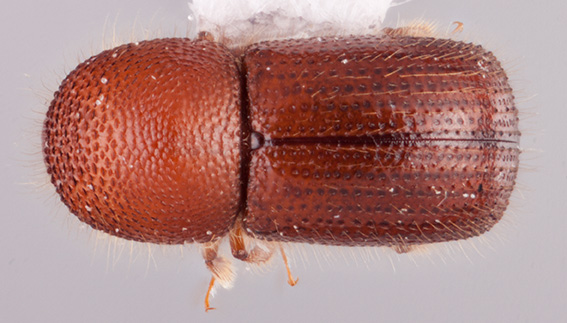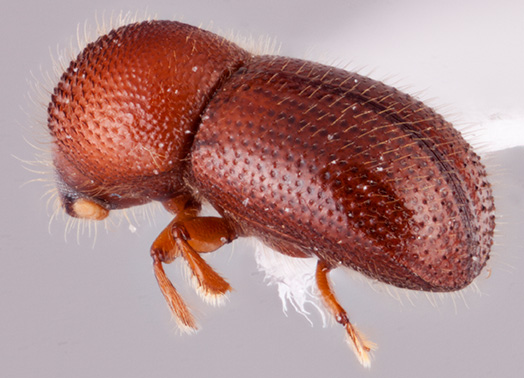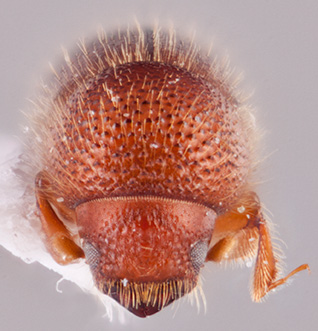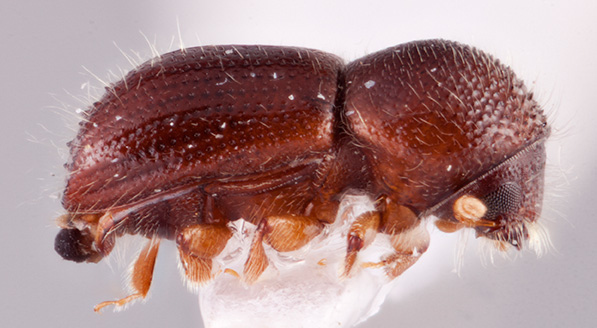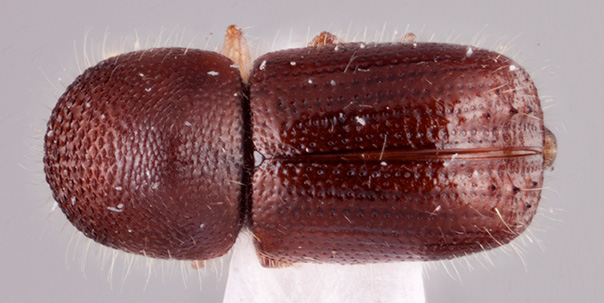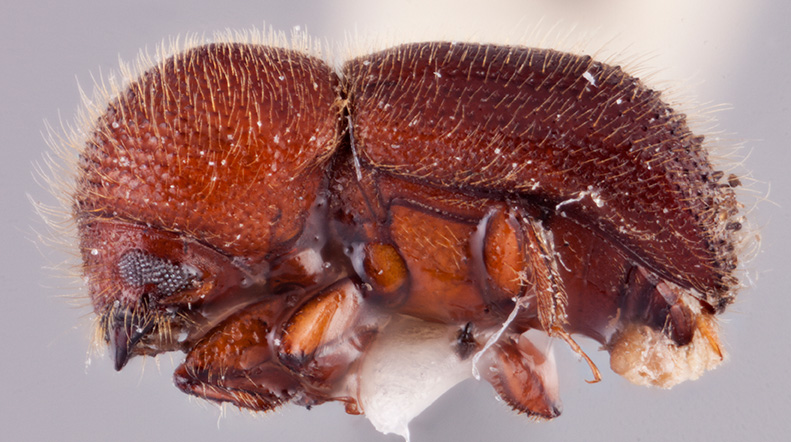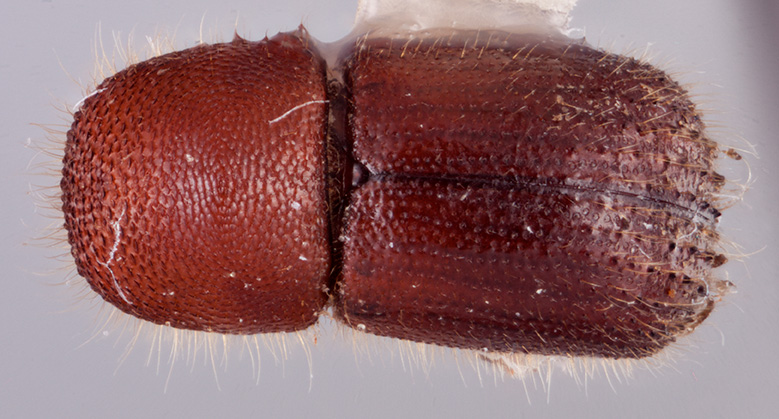Ambrosiodmus
|
Ambrosiodmus rubricollis; R.K. Osborn |
|
Ambrosiodmus rubricollis; R.K. Osborn |
|
Ambrosiodmus rubricollis; R.K. Osborn |
|
Ambrosiodmus rubricollis; R.K. Osborn |
|
Ambrosiodmus asperatus; R.K. Osborn |
|
Ambrosiodmus asperatus; R.K. Osborn |
|
Ambrosiodmus minor; R.K. Osborn |
|
Ambrosiodmus minor; R.K. Osborn |
Taxonomy
Ambrosiodmus Hopkins, 1915a: 55.
Synonyms
Phloeotrogus Motschulsky, 1863: 512. Wood, 1969: 113.
Brownia Nunberg, 1963: 37. Wood, 1980: 96.
Diagnosis
2.5−4.8 mm long, 1.7−2.8 times as long as wide, body usually stout and darkly colored. Ambrosiodmus can be distinguished by the pronotumpronotum:
the dorsal surface of the thorax
short, rounded; pronotal discdisc:
the flat central upper surface of any body part (e.g. pronotum and elytra) entirely asperateasperate:
entirely asperateasperate:
covered in asperities ; pronotum anterioranterior:
; pronotum anterioranterior:
the front or forward; opposite of posterior margin without a carinacarina:
margin without a carinacarina:
an elevated ridge or keel, not necessarily high or acute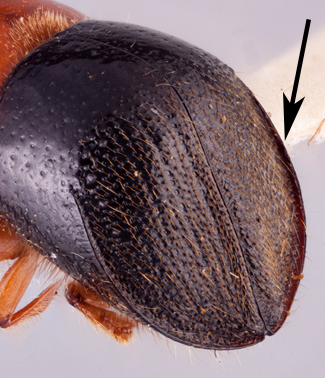 or serrations; elytral discdisc:
or serrations; elytral discdisc:
the flat central upper surface of any body part (e.g. pronotum and elytra) convexconvex:
convexconvex:
appearing rounded ; elytral declivitydeclivity:
; elytral declivitydeclivity:
downward slope of either the pronotum or elytra
 rounded and steep at apexapex:
rounded and steep at apexapex:
point or edge furthest from the body; opposite of base
 ; scutellum flat, flush with elytra; mycangial tufts absent; and procoxae contiguous.
; scutellum flat, flush with elytra; mycangial tufts absent; and procoxae contiguous.
May be confused with
Ambrosiophilus, Beaverium, and Immanus
Distribution
temperate and tropical regions of the world
Gallery system
This consists of a radial entrance tunnel leading to branched tunnels. These usually lie predominantly in one horizontal plane, but may extend into three dimensions. They lack enlarged brood chambers. Many gallery systems are often started in a small area of the tree. Unlike many xyleborines, the galleries of different individuals often interconnect so that beetles can move between galleries (Beeson 1961Beeson 1961:
Beeson CFC. 1961. The ecology and control of the forest insects of India and the neighbouring countries. 2nd edition. Government of India, New Delhi, 767 pp., Kasson et al. 2016Kasson et al. 2016:
Kasson MT, Wickert KL, Stauder CM, Macias AM, Berger MC, Simmons DR, Short DPG, DeVallance DB, Hulcr J. 2016. Mutualism with aggressive wood-degrading Flavodon ambrosius (Polyporales) facilitates niche expansion and communal social structure in Ambrosiophilus ambrosia beetles. Fungal Ecology 23: 86-96. https://doi.org/10.1016/j.funeco.2016.07.002).
Remarks
Recent studies suggest that all the species in Ambrosiodmus and Ambrosiophilus Hulcr and Cognato are associated with a single species of polypore basidiomycete ambrosia fungus (Flavodon ambrosius) (Kasson et al. 2016Kasson et al. 2016:
Kasson MT, Wickert KL, Stauder CM, Macias AM, Berger MC, Simmons DR, Short DPG, DeVallance DB, Hulcr J. 2016. Mutualism with aggressive wood-degrading Flavodon ambrosius (Polyporales) facilitates niche expansion and communal social structure in Ambrosiophilus ambrosia beetles. Fungal Ecology 23: 86-96. https://doi.org/10.1016/j.funeco.2016.07.002; Li et al. 2017Li et al. 2017:
Li Y, Bateman CC, Skelton J, Jusino MA, Nolen ZJ, Simmons DR, Hulcr J. 2017. Wood decay fungus Flavodon ambrosius (Basidiomycota: Polyporales) is widely farmed by two genera of ambrosia beetles. Fungal Biology 121: 984-989. https://doi.org/10.1016/j.funbio.2017.08.004). This fungus has greater ability to break down lignocellulose than most ambrosia fungi. This enables the beetles to colonize wood at a more advanced state of decay than most ambrosia beetles, and to persist in the same tree over several generations (Kasson et al. 2016Kasson et al. 2016:
Kasson MT, Wickert KL, Stauder CM, Macias AM, Berger MC, Simmons DR, Short DPG, DeVallance DB, Hulcr J. 2016. Mutualism with aggressive wood-degrading Flavodon ambrosius (Polyporales) facilitates niche expansion and communal social structure in Ambrosiophilus ambrosia beetles. Fungal Ecology 23: 86-96. https://doi.org/10.1016/j.funeco.2016.07.002; Li et al. 2017Li et al. 2017:
Li Y, Bateman CC, Skelton J, Jusino MA, Nolen ZJ, Simmons DR, Hulcr J. 2017. Wood decay fungus Flavodon ambrosius (Basidiomycota: Polyporales) is widely farmed by two genera of ambrosia beetles. Fungal Biology 121: 984-989. https://doi.org/10.1016/j.funbio.2017.08.004).


